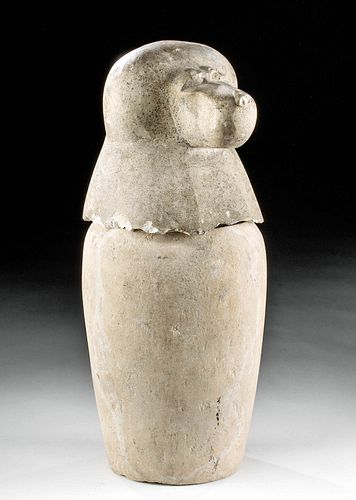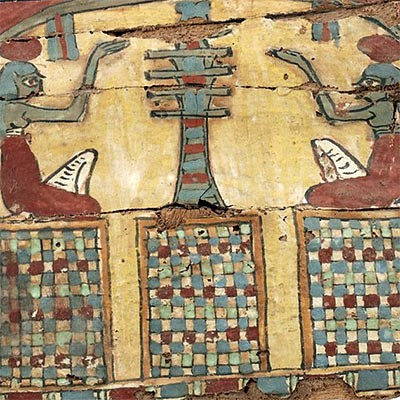Egyptian Limestone Canopic Jar Baboon Head Hapy Lid
Lot 1a
About Seller
Artemis Fine Arts
686 S Taylor Ave, Ste 106
Louisville, CO 80027
United States
Selling antiquities, ancient and ethnographic art online since 1993, Artemis Gallery specializes in Classical Antiquities (Egyptian, Greek, Roman, Near Eastern), Asian, Pre-Columbian, African / Tribal / Oceanographic art. Our extensive inventory includes pottery, stone, metal, wood, glass and textil...Read more
Categories
Estimate:
$7,000 - $10,000
Absentee vs Live bid
Two ways to bid:
- Leave a max absentee bid and the platform will bid on your behalf up to your maximum bid during the live auction.
- Bid live during the auction and your bids will be submitted real-time to the auctioneer.
Bid Increments
| Price | Bid Increment |
|---|---|
| $0 | $25 |
| $300 | $50 |
| $1,000 | $100 |
| $2,000 | $250 |
| $5,000 | $500 |
| $10,000 | $1,000 |
| $20,000 | $2,500 |
| $50,000 | $5,000 |
| $100,000 | $10,000 |
| $200,000 | $20,000 |
About Auction
By Artemis Fine Arts
Jul 30, 2020
Set Reminder
2020-07-30 10:00:00
2020-07-30 10:00:00
America/New_York
Bidsquare
Bidsquare : Ancient / Ethnographic From Around the World
https://www.bidsquare.com/auctions/artemis-gallery/ancient-ethnographic-from-around-the-world-5382
Ancient art from Egypt, Greece, Italy and the Near East, as well as Asian, Pre-Columbian, Native American, African / Tribal / Oceanic, Spanish Colonial, Russian Icons, Fine art, much more! All categories, all price ranges... all legally acquired and guaranteed to be as described or your money back. Artemis Fine Arts info@artemisfinearts.com
Ancient art from Egypt, Greece, Italy and the Near East, as well as Asian, Pre-Columbian, Native American, African / Tribal / Oceanic, Spanish Colonial, Russian Icons, Fine art, much more! All categories, all price ranges... all legally acquired and guaranteed to be as described or your money back. Artemis Fine Arts info@artemisfinearts.com
- Lot Description
Ancient Egypt, Third Intermediate to Late Dynastic Period, 21st to 31st Dynasty, ca. 1070 to 332 BCE. A fine canopic jar, hand-carved from white limestone that has taken on an age-commensurate beige-yellow hue. The flat-bottomed cylindrical vessel has an inverted piriform body with smooth walls and a slightly swelled shoulder, an interior rim that slopes gently inward to accommodate a lid, and traces of black decorative pigment on the shoulder as well as a faded frontal column of hieroglyphs. Surmounting the jar body is the handsome primate countenance of Hapy - the baboon-headed of four Sons of Horus - bearing semicircular eyes with elongated corners, a rounded snout with a shallow nasal ridge, sunken jowls along the upper cheeks, and a lobed mane with a slight central protrusion. The exterior of both body and lid exhibits an incredibly smooth texture that creates a pleasing tactile sensation. Size (lid): 5.125" W x 5.9" H (13 cm x 15 cm); (body): 5.4" W x 7.75" H (13.7 cm x 19.7 cm); 12.8" H (32.5 cm) with lid.
Canopic jars like this example were used to contain and protect the internal organs of a deceased individual and are some of the most iconic artifacts from ancient Egypt. The tradition of ceremonial organ removal during the mummification process was created around the Fourth Dynasty (ca. 2613 BCE) and was originally designed to contain the organs in a multi-chambered canopic box, however the Middle Kingdom saw the increased preference of jars over boxes. The New Kingdom's 18th Dynasty marked another shift in canopic traditions when jar lids were fashioned to resemble the heads of the Sons of Horus, four different-headed deities who were charged with protecting the various internal organs of Osiris during his journey through the afterlife and resurrection. The Son of Horus depicted here is Hapy (also Hapi), the baboon-headed divinity associated with the northern direction who is charged with protecting the lungs while himself being associated with and protected by the goddess Nephthys.
For a stylistically similar example, please see The Metropolitan Museum of Art, accession number 13.181.2a,b.
For another stylistically similar example of a baboon-headed canopic jar lid, please see The Metropolitan Museum of Art, accession number 1971.224.
A stylistically similar example of a jar and lid, from the Late Dynastic Period and carved from alabaster, hammered for $21,250 at Sotheby's, New York "Antiquities" auction (June 8, 2011, lot 94).
Provenance: private Akron, Ohio, USA collection, acquired between 1975 and 1985
All items legal to buy/sell under U.S. Statute covering cultural patrimony Code 2600, CHAPTER 14, and are guaranteed to be as described or your money back.
A Certificate of Authenticity will accompany all winning bids.
We ship worldwide and handle all shipping in-house for your convenience.
#153795Both lid and body are from the same time period but are likely not original to one another. Jar body repaired from multiple large pieces, with small areas of restoration to walls and base, and resurfacing with very light adhesive residue along new material and break lines. Repair to nose of baboon with small chips around break line. Lid has chips to baboon face, lower peripheries, and plug base, with softening to some finer details, and fading to original pigment on eyes. Jar has chips and abrasions to base, walls, and rim, with fading to original pigment, and staining within interior. Body and lid have light earthen deposits and smooth surfaces throughout.Condition
- Shipping Info
-
All shipping is handled in-house for your convenience. Your invoice from Artemis Gallery will include shipping calculation instructions. If in doubt, please inquire BEFORE bidding for estimated shipping costs for individual items.
-
- Buyer's Premium



 EUR
EUR CAD
CAD AUD
AUD GBP
GBP MXN
MXN HKD
HKD CNY
CNY MYR
MYR SEK
SEK SGD
SGD CHF
CHF THB
THB
















